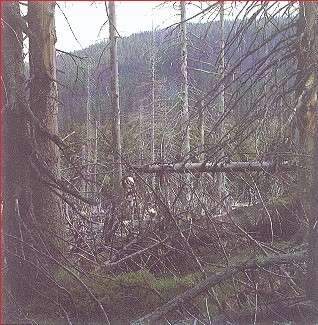Sources of Air Pollution
![]()
 The sources of
the severe ecological situation, in the industrialised regions
of Poland, are related to the use of coal for electrical power
and heat, in industry and in the municipal sector. The sources
of air pollution are also, and perhaps most certainly related
to the fundamental characteristics of the communist economy, such
as:
The sources of
the severe ecological situation, in the industrialised regions
of Poland, are related to the use of coal for electrical power
and heat, in industry and in the municipal sector. The sources
of air pollution are also, and perhaps most certainly related
to the fundamental characteristics of the communist economy, such
as:
ñ domination of extraction and heavy industry, which characterises
itself as being the most harmful to the environment
ñ building of gigantic industrial compounds, which usually
house the greatest concentration of tHReats to the environment
ñ low energy prices, which encourage wastefulness in industry
as well as in the private sector
ñ lack of reflection of the true costs of production with
respect to the products, which keeps old, exploited factories
in operation, these being particularly harmful to the environment
Moreover, the former communist government, as the sole owner and caretaker of industrial plants, was not interested in providing rigorous laws which would force the use of environmentally safe technology. Instead, the government directed its funds and energies into technology which solely existed for production purposes.
The effect of this type of politics was a pollution of the atmosphere which depended on and related to the potential of production in Poland. This relation of pollution to production is particularly evident when the figures, which compare Polandís emission of the main atmospheric pollutants (with respect to national income, energy con../picption, or SIZE of the country) with the other countries of the OECD, are analysed (TABLE ñ with information on emission of main atmospheric pollutants in Poland and the countries of the OECD). Clearly, according to the data in the TABLE, Poland emits far greater amounts of main atmospheric pollutants than the countries of the OECD. This confirms the great distance that Poland still needs to overcome before it has an effective economy which does as little harm to the environment as possible.
After the political changes in 1989, the most important
and critical goals for the protection of the atmosphere were:
ñ an increase in energy prices so that there would be an
initiative to economise
ñ introduction of allowable limits of SO2, NOx,
and dust emissions
ñ eradication of old industrial plants, which were harmful
to the environment, especially those in Upper Silesia and in other
large industrialised areas of Poland
ñ building of installations which would lower the amount
of sulphur and dust in hard coal, as well as building of installations
which would desulphurize fumes
ñ liquidation of the so-called ëslightly emitting
sourcesí of atmospheric
pollution (small broiler rooms and tile stoves) in the centres
of the large Polish cities, as well as in health resort areas
ñ lessening of emissions of gases which cause changes in
the earthís climate (the so-called ëgreenhouse gasesí)
by limiting the methane emitted from the coal mines and city landfills,
as well as elimination of freon used as a cooling agent in industry
All of these goals were included in "The Political Ecology of the Nation", which was approved by the government and parliament in 1992, becoming the basis for effective measurements which will be taken to make up for the many years of environmental neglect, in the shortest possible time.